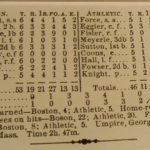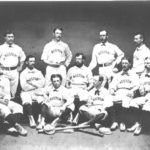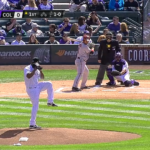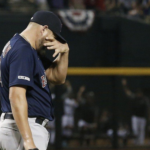Early Season Evaluation: What Player Statistics to Watch
 Early in the season, baseball fans – especially fantasy baseball fans – are prone to react very quickly to any new player information. Hell, a few years back I remember clamoring to blow my FAAB wad on Kansas City’s Emilio Bonifacio following a quick start only to watch him turn into a pumpkin just as fast.
Early in the season, baseball fans – especially fantasy baseball fans – are prone to react very quickly to any new player information. Hell, a few years back I remember clamoring to blow my FAAB wad on Kansas City’s Emilio Bonifacio following a quick start only to watch him turn into a pumpkin just as fast.
I say “a few years back,” but who am I kidding? I find myself falling into the same lightning quick reactions today. I’m disappointed I didn’t get any shares of the red hot Adam Eaton and wondering what the hell I was thinking spending $18 on AT&T Park’s Andrew McCutchen – despite his 6-for-7 game and walk-off HR on Saturday.
In a way, we need to react quickly in fantasy baseball. Competition is fierce. Anyone with an Internet connection and a Twitter account is seconds away from a near endless stream of real-time information. Waiting on a hot start to assure yourself that it’s real, and not just smoke and mirrors, is one of the easiest ways to fall behind.
We shouldn’t be too quick to react, but we also can’t sit on our asses while we wait for true talent levels to reach equilibrium. So, then what the hell am I saying!? Well, maybe we can jump the gun; maybe we can have our cake and eat it, too.
What statistics should we be looking at, and what should we be ignoring? Are there certain stats that tend to become meaningful more quickly? Conversely, are there certain stats that take longer to more accurately tell the story? Are there certain stats that might better portend a breakout, and others that tend to be more noise?
Why, yes! Yes, there are. With the help of the FanGraphs Sample Size Guide, among others, we see that certain hitting and pitching stats tend to become more meaningful faster than others.
(Quick meandering disclaimer: this doesn’t mean that these stats tell us what a player will do going forward, but rather, once certain sample sizes are reached they become more reliable descriptors of a certain player’s abilities as it pertains to what they have done. This does not mean, however, that the stat has “stabilized.” In fact, just as having 5 PA of data is better than 1 PA. The same is true of sample sizes – the more sample we have, the more confidence we can feel in our information, or the more stable it becomes – yet not necessarily “stabilized.”)
Alright, enough with the legal mumbo jumbo. Per FanGraphs, what stats should we be looking at, and perhaps just as importantly, what stats should we be more inclined to ignore?
Hitting
Pay Attention To:
1. Strikeout Rate (K%) – 60 PA “stabilization”
2. Walk Rate (BB%)– 120 PA
3. FB & GB Rates – 80 Balls in Play (BIP)
Ignore:
1. Batting Average – 910 AB
2. BABIP – 800 BIP
3. LD Rate – 600 BIP
Pitching
Pay Attention To:
1. Strikeout Rate (K%) – 70 Batters Faced (BF)
2. Walk Rate (BB%) – 70 BF
3. FB & GB Rates – 70 Balls in Play (BIP)
Ignore:
1. BABIP – 2,000 BIP
2. HR Rate – 1,320 BF
3. LD Rate – 650 BIP
Ahh, what a surprise… many of the same stats exist across both lists. It would appear that early in the season we should be looking at strikeouts, walks, and flyballs/groundballs, while ignoring batting average, BABIP, and line-drive rate.
Additionally, with the advent of Statcast, there’s some new research that suggests exit velocity “stabilizes” fairly quickly as well (40 BIP). Also, notice how the swing- and pitch-level data tends to become more stable quicker, while results-oriented stats like batting average and BABIP take a full season.
And given that swing-level stats like O-Swing%, Z-Contact%, and Contact% have a strong relationship with strikeout rates, let’s take a look at those too. Let’s add in Swinging Strike Rate (SwStr%) for shits and gigs. That leaves us to look into strikeouts (K%, O-Swing%, Z-Contact%, Contact%, SwStr%), walks (BB%), groundball/flyball ratio (GB/FB), and exit velocities.
Additionally, there’s evidence that pitching velocity becomes meaningful almost instantly, meaning we should add it to our list of things to monitor, perhaps among the highest priorities.
Lastly, there are a few other things worth noting as we look for any possible informational edge early in the season, particularly as it pertains to potential “breakout” players. On the pitching side, in addition to velocity, pay special attention to pitch mix changes (e.g., Patrick Corbin throwing his slider 50% of the time).
On the hitting side, don’t forget about simple things such as lineup spot (Jeff Zimmerman of FanGraphs has been covering this well, for both the AL and NL). Similar to pitchers, hitters’ exit velocities should become meaningful fairly quickly. We don’t know a ton about when launch angle stabilizes, but we’ll take also give it a look alongside GB and FB rates.
Wrapping Up
I know we discussed a ton of information today – and somehow zero players! You might think this has all been one big tease, a weak build-up with no grand finale. Not so fast! We’ll be using these stats as our roadmap in the coming weeks to look at interesting trends and plays – both good and bad. We won’t necessarily wait until each “stabilization” point, but we will sequence in rough order of it:
- Lineup Position (AL and NL already covered)
- Pitching Velocity & Pitch Mix
- Hitting Exit Velocity
- Strikeouts (K%)
- GB%, FB%, Launch Angle
- Walk Rate (BB%)
Our roadmap for the coming weeks is set, we know (or think we know) the best numbers to pay attention to, to best predict what’s most likely to happen the rest of the season. (We’ll almost certainly fail at this, but it will be fun trying!)
The race is on to uncover this year’s waiver wire or buy-low heroes, such as last year’s Justin Smoak, Logan Morrison, Whit Merrifield, and so on. In the meantime, I hope this gives you enough ammunition to do your own research for now, and stay tuned as we discuss the implications of this in the coming weeks!


























